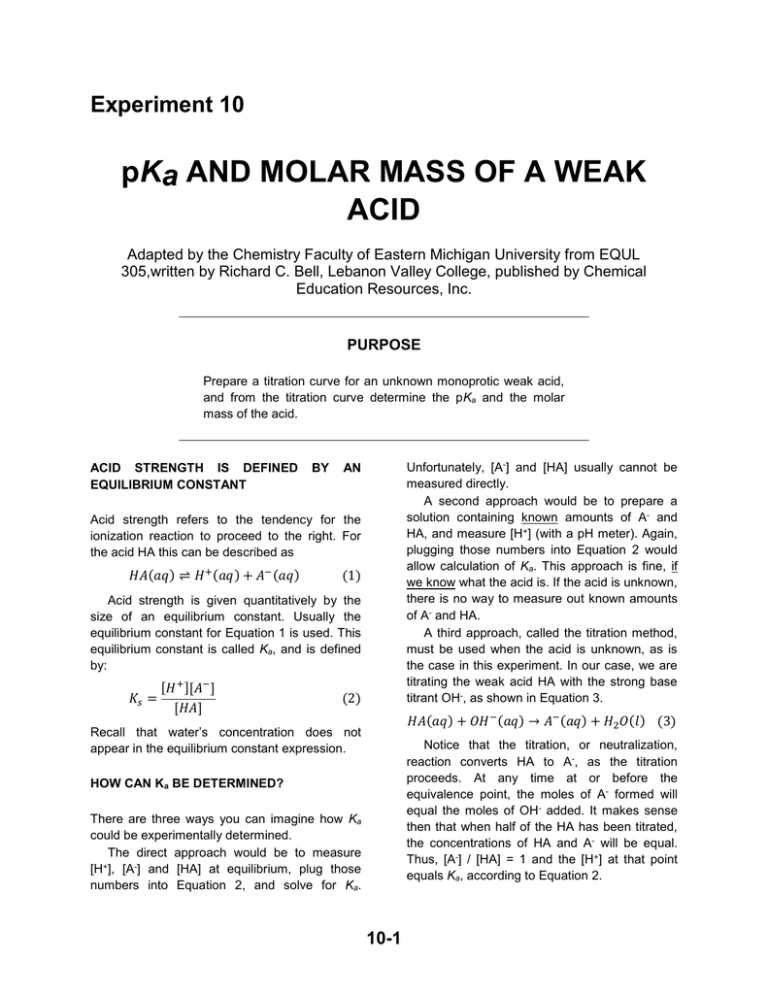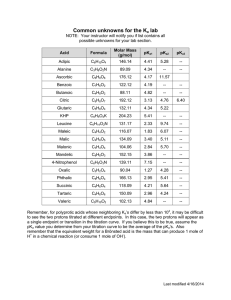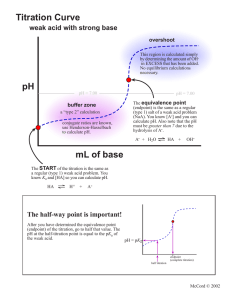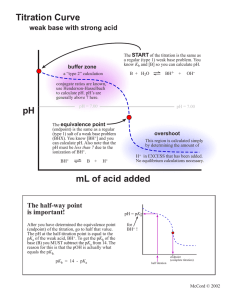Ka ACID Experiment 10
advertisement

Experiment 10 pKa AND MOLAR MASS OF A WEAK ACID Adapted by the Chemistry Faculty of Eastern Michigan University from EQUL 305,written by Richard C. Bell, Lebanon Valley College, published by Chemical Education Resources, Inc. PURPOSE Prepare a titration curve for an unknown monoprotic weak acid, and from the titration curve determine the pKa and the molar mass of the acid. ACID STRENGTH IS DEFINED EQUILIBRIUM CONSTANT BY Unfortunately, [A-] and [HA] usually cannot be measured directly. A second approach would be to prepare a solution containing known amounts of A- and HA, and measure [H+] (with a pH meter). Again, plugging those numbers into Equation 2 would allow calculation of Ka. This approach is fine, if we know what the acid is. If the acid is unknown, there is no way to measure out known amounts of A- and HA. A third approach, called the titration method, must be used when the acid is unknown, as is the case in this experiment. In our case, we are titrating the weak acid HA with the strong base titrant OH-, as shown in Equation 3. AN Acid strength refers to the tendency for the ionization reaction to proceed to the right. For the acid HA this can be described as 𝐻𝐴(𝑎𝑞) ⇌ 𝐻 + (𝑎𝑞) + 𝐴− (𝑎𝑞) (1) Acid strength is given quantitatively by the size of an equilibrium constant. Usually the equilibrium constant for Equation 1 is used. This equilibrium constant is called Ka, and is defined by: 𝐾𝑠 = [𝐻 + ][𝐴− ] [𝐻𝐴] (2) 𝐻𝐴(𝑎𝑞) + 𝑂𝐻 − (𝑎𝑞) → 𝐴− (𝑎𝑞) + 𝐻2 𝑂(𝑙) (3) Recall that water’s concentration does not appear in the equilibrium constant expression. Notice that the titration, or neutralization, reaction converts HA to A-, as the titration proceeds. At any time at or before the equivalence point, the moles of A- formed will equal the moles of OH- added. It makes sense then that when half of the HA has been titrated, the concentrations of HA and A- will be equal. Thus, [A-] / [HA] = 1 and the [H+] at that point equals Ka, according to Equation 2. HOW CAN Ka BE DETERMINED? There are three ways you can imagine how Ka could be experimentally determined. The direct approach would be to measure + [H ], [A-] and [HA] at equilibrium, plug those numbers into Equation 2, and solve for Ka. 10-1 Experiment 10 – pKa and Molar Mass of a Weak Acid How can you tell when you have titrated half of an unknown sample? The trick is to titrate the entire sample, and then say that the midpoint of the titration was the point where you had added half the amount of titrant necessary to get to the equivalence point. If you keep track of the solution's pH throughout the titration, you can determine the Ka simply by noting what the pH was at the midpoint. and pKa, it is often perceived as a more convenient form of the equilibrium constant expressioneven if it is harder to spell. Notice how Equation 5 describes the Ka = [H+] condition at the midpoint of a titration. It tells us that pH = pKa when [A-] = [HA], because [A-] / [HA] = 1 and log 1 = 0. In other words, the pH halfway through a titration equals the pKa of the acid being titrated. WHAT IS THIS pKa BUSINESS? WHAT IS A TITRATION CURVE? We have tried to convince you in lecture and in the previous experiment that pH was a convenient way to describe [H+]. For similar reasons, we often simplify the expression of equilibrium constants by referring instead to their negative logarithms, or pK's. For example, pKa = -log Ka. Values of weak acid pKa's run from about 1 to 14. Because pKa's are commonly used, rather than Ka's, and because pH is more commonly measured, rather than [H+], the Ka expression is usually used in a form containing pKa and pH, rather than Ka and [H+]. This alternative form of the Ka expression can be derived by taking minus the log of both sides of Equation 3, and remembering (from algebra) that the log (ab) = log a + log b. Thus, A titration curve is a graph of the pH of a solution (y axis) as a function of how much titrant has been added (x axis). To make a titration curve, you must measure the pH of the solution being titrated after each of numerous additions of titrant, and you must carefully record the volume of titrant used after each addition. Then, pH is simply plotted against total amount of titrant added. Titration curves have that characteristic wiggle shape. They are flat at the ends and steep in the middle. This shape basically results from the fact that pH is a log function. Each pH unit corresponds to a factor of ten change in [H+], and it takes much more acid or base to change the concentration by a factor of ten at the extremes of the pH range. An example titration curve is presented in Figure 1. − log 𝐾𝑎 = − log ( [𝐻 + ][𝐴− ] ) [𝐻𝐴] − log 𝐾𝑎 = − log ([𝐻 +] [𝐴− ] ) [𝐻𝐴] − log 𝐾𝑎 = − log[𝐻 + ] − log ( [𝐴− ] ) [𝐻𝐴] (4) which, upon substituting the symbols for pKa and pH and rearranging so that pH is on the left, gives us [𝐴− ] 𝑝𝐻 = 𝑝𝐾𝑎 + log ( ) [𝐻𝐴] (5) Equation 5 is especially popular with biochemists, who refer to it as the HendersonHasselbalch equation. It contains neither more nor less information than the original Ka expression. But, because it directly relates pH Figure 1. A typical titration curve for a weak acid titrated by a strong base (NaOH). 10-2 Experiment 10 – pKa and Molar Mass of a Weak Acid WHERE IS THE EQUIVALENCE POINT? The equivalence point, or endpoint, is indicated by the center of the steep part of the titration curve. At this point, the moles of base added equals the moles of acid originally in the sample. So, the mass of the acid divided by the moles of base added equals the molar mass of the acid. Locating the center of the steep part of the titration curve can be somewhat arbitrary. Mathematically, the equivalence point is located where the curve is the steepest; that is, it has the largest change in pH per change in volume (first derivative). A graph of the first derivative vs. volume is shown in Figure 2. Notice in Figure 1 that the equivalence point is around pH 9. If this had been the titration of a strong acid with NaOH, the equivalence point would have been at pH 7. However, because of hydrolysis by the conjugate base formed during the titration of a weak acid, the pH at the equivalence point is slightly basic. Figure 2. First derivative vs. volume for the titration curve shown in Figure 1 (this graph is mistitled). The largest value of the first derivative is at the volume corresponding to the equivalence point (10.7 mL). changes direction). It is the point where the titration curve is closest to flat, or, where the pH changes the least upon addition of base. In other words, this is a buffer solution! You can see that buffering is best at pH = pKa, where there are equal amounts of the acid and conjugate base. HOW TO SEE BUFFERING AND FIND pKa The volume of titrant halfway from the origin to the equivalence point corresponds to the point where half of the acid has been titrated, or converted to its conjugate base. This is the point where [A-] = [HA], and, according to equation (5), pH = pKa. Thus, the pKa is easily determined from the titration curve just by noting the pH at the volume halfway to the equivalence point. So, for the acid in Figure 1, pKa = pH at 5.35 mL (= ½ of 10.7 mL), which is about 5.1. Notice in Figure 1 that the halfway point is an inflection point (i.e., place where the curvature IN THIS EXPERIMENT You will titrate a sample of an unknown monoprotic acid. A titration curve will be constructed, and from it you will determine the equivalence point volume and the pKa of the acid. From the moles of base required to reach the equivalence point, and from the mass of your sample titrated, you will determine the molar mass of the unknown acid. PRE-LABORATORY PREPARATION 1. Read the procedure and data analysis sections of the experiment. 2. Complete the computer-generated PRELAB assignment. Refer to the procedure and data analysis sections of the experiment as needed. The prelab questions for this experiment guide you to determine the appropriate sample size to use and will prepare you to calculate the unknowns’s molar mass. 3. Construct a complete, organized data sheet. All pH data will be collected by computer and do not need to be recorded on the data sheet. All you need to record are the [NaOH] and the mass of acid used. 10-3 EXPERIMENTAL SECTION REAGENTS PROVIDED (e) Enter the pH of the buffer solution. Wait until the voltage reading stabilizes and then click on Keep. (f) Remove the electrode, rinse it, and place it in the other buffer solution and swirl it briefly. (g) Enter the pH of the second buffer solution. Wait until the voltage reading stabilizes and then click Keep.. (h) Click on Done and then close the LabPro interface window. NaOH(aq), approximately 0.05 M. Unknown acid. Hazardous Chemicals Handle the acid and base solutions with care. WASTE DISPOSAL 2. Set up LoggerPro to graph the titration curve. To do this: (a) Choose Experiment Data Collection…. (b) Change the mode to Events with Entry. (c) For the column label enter Volume (d) Leave the short label as is. (e) For the units enter mL (f) Click on Done. All of the chemicals used in this experiment may be safely disposed of by washing down the sink. PROCEDURE Unless told otherwise, you will do this experiment with a partner (or two, if necessary). SAMPLE PREPARATION SET UP FOR DATA COLLECTION 3. Clean a 50 mL buret, and load it with standardized NaOH (approximately 0.05 M). Position the meniscus exactly on 0.00 mL. Record the actual NaOH concentration on your Data Sheet. 1. Set up and do a two-buffer calibration of your pH electrode, as in the last experiment: (a) Start LOGGER PRO and connect the pH amplifier to CH 1 on the interface box and connect the pH electrode to the pH amplifier. (b) Click on the interface box icon and then select the pH probe from the scroll box of Analog Probes and click-and-drag it into the box for CH 1. (Alternately, click on the white box for CH 1 and click on Choose Sensor, then pH/mV/ORP Amplifier and then pH.) (c) Rinse the electrode and then immerse it in a pH 4 or 7 buffer solution and swirl it. (d) Click on the white box for CH 1. From the menu click on Calibrate…. Then click on the Calibrate Now box. 4. Weigh out a trial sample of your unknown acid on weighing paper and transfer it into a 250 mL beaker (see prelab calculations). Record the unknown number and mass on your Data Sheet. 5. Add about 75 mL of distilled water to dissolve the unknown acid. 10-4 Experiment 10 – pKa and Molar Mass of a Weak Acid do not take these readings it will be difficult to precisely locate the equivalence point! PERFORM THE TITRATION 6. Immerse the pH electrode in the unknown solution, and position the buret so the tip is over the beaker. If you enter the wrong volume or hit the keep button at the wrong time, the volumes that you enter can be edited at any time. Just click on the cell in the data table and change it to the correct value. If there is a measured pH value to be deleted, this can only be done after you have finished collecting all of your data and you have hit the Stop button. To delete a point, click on the row number in the data table and then select Edit – Strikethrough Data Cells from the menus. So you don’t need to panic or start over. If you accidentally hit the Stop button too soon, you can resume by clicking on the Collect button and then choosing Append to Latest. 7. Click on the Collect button in the upper right of the screen. Do NOT open a new meter window after clicking Collect. This tends to cause the program to freeze up and you will need to start over. 8. Wait until the pH reading stabilizes, then hit the Keep button. Type the initial buret reading (0) into the box that appears and hit the Enter key on the keyboard. 9. Titrate the acid. To do this: (a) Add enough NaOH from the buret to increase the pH by about 0.1 to 0.2. See the discussion below for more information.) (b) Stir the solution. (c) Click Keep when the pH reading stabilizes. (d) Type the buret reading (to the nearest 0.01 mL) into the box and hit the Enter key. 10. Click on the Stop button when you are finished collecting data. 11. Decide whether to repeat the titration. If you are satisfied with your first titration and you have sufficient data and did not miss the equivalence point, you may proceed to step 14. Otherwise, repeat the titration taking advantage of what you've learned from the trial titration. Note the regions where the pH changes slowly and rapidly. If you repeat the titration, you may wish to optimize your sample size (so it will take 30 mL to reach the equivalence point). Remember: a buret tells you the volume delivered, not the volume actually in the buret. So, just record the volume delivered – you do not need to subtract from 50. The more readings you make, the nicer curve you will get. The readings do not have to be equally spaced. It makes sense to add larger increments of titrant when the pH is changing little (but no more than 1 mL at a time), and very small increments when the pH is changing rapidly. In fact, you should go one-drop-at-atime near the equivalence point. You should rescale the graph axes as necessary to get a good view of your graph. A typical graph might show pH values between 3 and 11 and volumes from 0 to 50 mL. Take readings until you are well past the equivalence point (by at least 8 mL), into the region where the pH is changing slowly again (the last flat part of the curve in Figure 1). If you 12. Save your data in a file (just in case the program crashes during data analysis – which occasionally happened with earlier versions of the software). Choose File – Save and then enter a title of your choice and save the file on the Desktop. 13. Add a suitable title to your graph, be sure everything is labeled properly, and then print out a copy of your titration curve. While your graph is printing, clean up your station and glassware and then wash your hands. 10-5 Experiment 10 – pKa and Molar Mass of a Weak Acid (c) Click on Done. Change the graph axes so that the derivative is on the y-axis. The graph should now show First Derivative vs. Volume. The peak in the first derivative graph should be at the same volume as the steep rise on the titration curve. If not, something is wrong. Get assistance if necessary. (d) Change the title, make sure everything is labeled properly, and print out this graph. DATA ANALYSIS 14. To aid in determining the location of the equivalence point, we will construct a first derivative graph (similar to figure 2). To do this: (a) Select Data New Calculated Column. (b) For the long name, enter First Derivative. For the short name, enter FD. Enter pH/Volume for the units. In the equation box enter derivative(“pH”). The easiest way to do this is to click on functions and then choose calculus and then derivative() and then click on variables and choose “pH”. 15. Print out the complete Data Table. 10-6 Experiment 10 – pKa and Molar Mass of a Weak Acid Name Partner Station Used Partner Instructor/Day/Time Station Checked & Approved DATA SHEET Record any observations, concentrations, masses, or other useful data gathered during the experiment. 10-7 Experiment 10 – pKa and Molar Mass of a Weak Acid DATA ANALYSIS All calculations must be clearly organized, make proper use of significant figures and include the units. 1. Determine the volume at the equivalence point from looking at your two graphs. Since, it is not easy to read the graphs precisely, use your printed data table to more accurately determine the equivalence-point volume. equivalence-point volume _________________________ 2. Determine pKa from your graph. To do this, on your printed titration curve: (a) mark and label the equivalence point; (b) mark the midpoint volume on the x-axis (point at one-half the volume used to get to the equivalence point); (c) draw a vertical line from point (b) to the titration curve; and (d) draw a horizontal line from the marked point on the titration curve (point (c)) to the y-axis. Since it can be difficult to accurately read off of the graph, you should use your data table to confirm your value (interpolating or averaging as necessary). Report your results to the number of significant figures of which you are confident. Enter the requested values below: midpoint volume _____________________ pKa _________________ 3. Calculate the molar mass of your unknown acid. Molar Mass of Unknown Acid____________________ Unknown Number____________________ "The lab has ended. Depart in peace." 10-8





